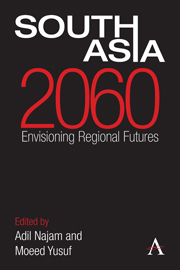Book contents
- Frontmatter
- Contents
- Acknowledgments
- List of Abbreviations
- Introduction: Imagining South Asian Futures
- Section I South Asia as a Region
- Section II State Relations
- Section III Development
- Section IV Human Well-Being
- Chapter 27 Population Dynamics, Economic Prospects and Regional Coherence
- Chapter 28 Towards Cooperation for Poverty Reduction?
- Chapter 29 Health Challenges
- Chapter 30 Regional Disease Dynamics
- Chapter 31 Education: Time Bomb or Silver Bullet?
- Chapter 32 Scholarship in and on South Asia
- Chapter 33 Rights and Justice: A Prospective View
- Chapter 34 Patriarchy, Power and Paradox: Dreaming Gender Equality and Development
- Chapter 35 Women in South Asia
- Chapter 36 Media: New Trends, Old Problems
- Chapter 37 Sports: Passion and Industry
- About the Authors
- Bibliography
- Index
Chapter 35 - Women in South Asia
from Section IV - Human Well-Being
Published online by Cambridge University Press: 05 September 2013
- Frontmatter
- Contents
- Acknowledgments
- List of Abbreviations
- Introduction: Imagining South Asian Futures
- Section I South Asia as a Region
- Section II State Relations
- Section III Development
- Section IV Human Well-Being
- Chapter 27 Population Dynamics, Economic Prospects and Regional Coherence
- Chapter 28 Towards Cooperation for Poverty Reduction?
- Chapter 29 Health Challenges
- Chapter 30 Regional Disease Dynamics
- Chapter 31 Education: Time Bomb or Silver Bullet?
- Chapter 32 Scholarship in and on South Asia
- Chapter 33 Rights and Justice: A Prospective View
- Chapter 34 Patriarchy, Power and Paradox: Dreaming Gender Equality and Development
- Chapter 35 Women in South Asia
- Chapter 36 Media: New Trends, Old Problems
- Chapter 37 Sports: Passion and Industry
- About the Authors
- Bibliography
- Index
Summary
The myriad of economic, social and political transformations that are occurring throughout the South Asian subcontinent are reflected, to a considerable extent, in the kinds of changes women have been undergoing in the region and the challenges that lie ahead. The pervasive impact of the global economy throughout the region is forcing more women to need to earn an income, but there are few opportunities in the formal sector of South Asia's economies to incorporate them. Female literacy rates among young girls are rising today, but this doesn't help their mothers find jobs. What girls are learning in schools is also problematic: will this knowledge truly open economic and political doors for women in the future, or is it reinforcing stereotypes of maternal nurturing and submission? The entire region has implemented legal reforms to eliminate discrimination against women and to promote and protect their rights, but what is it that needs to occur to translate these new rights into common practices (e.g., allowing women actually to inherit land and reducing sexual harassment through legislation)? Finally, to change political agendas, women need to find their voices and be listened to; with the embedded patriarchy characteristic of most of South Asia, this may prove to be the hardest obstacle of all to surmount.
- Type
- Chapter
- Information
- South Asia 2060Envisioning Regional Futures, pp. 277 - 283Publisher: Anthem PressPrint publication year: 2013



